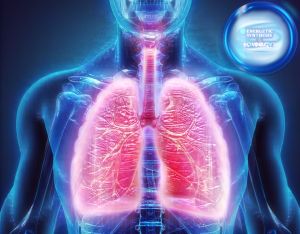Lungs
The Lungs are the primary organs of the respiratory system in humans and many other animals. In mammals and most other vertebrates, two lungs are located near the backbone on either side of the heart. Their function in the respiratory system is to extract oxygen from the atmosphere and transfer it into the bloodstream, and to release carbon dioxide from the bloodstream into the atmosphere, in a process of gas exchange. Respiration is driven by different muscular systems in different species. Mammals, reptiles and birds use their different muscles to support and foster breathing. In early tetrapods, air was driven into the lungs by the pharyngeal muscles via buccal pumping, a mechanism still seen in amphibians. In humans, the main muscle of respiration that drives breathing is the diaphragm. The lungs also provide airflow that makes vocal sounds including human speech possible.

Humans have two lungs, a right lung, and a left lung. They are situated within the thoracic cavity of the chest. The right lung is bigger than the left, which shares space in the chest with the heart. The lungs together weigh approximately 1.3 kilograms (2.9 lb), and the right is heavier. The lungs are part of the lower respiratory tract that begins at the trachea and branches into the bronchi and bronchioles, and which receive air breathed in via the conducting zone.
The tissue of the lungs can be affected by a number of respiratory diseases, including pneumonia and lung cancer. Chronic obstructive pulmonary disease includes chronic bronchitis and emphysema, and can be related to smoking or exposure to harmful substances. A number of occupational lung diseases can be caused by substances such as coal dust, asbestos fibres, and crystalline silica dust. Diseases such as bronchitis can also affect the respiratory tract. Medical terms related to the lung often begin with pulmo-, from the Latin pulmonarius (of the lungs) as in pulmonology, or with pneumo- (from Greek πνεύμων "lung") as in pneumonia.
In embryonic development, the lungs begin to develop as an outpouching of the foregut, a tube which goes on to form the upper part of the digestive system. When the lungs are formed the fetus is held in the fluid-filled amniotic sac and so they do not function to breathe. Blood is also diverted from the lungs through the ductus arteriosus. At birth however, air begins to pass through the lungs, and the diversionary duct closes, so that the lungs can begin to respire. The lungs only fully develop in early childhood.
About 20,000 protein coding genes are expressed in human cells and almost 75% of these genes are expressed in the normal lung.
Microbiome
There is a large presence of microorganisms in the lungs known as the lung microbiome or microbiota. The lung microbiome interacts with the airway epithelial cells. The microbiome is complex in healthy people, and altered in diseases such as asthma and COPD. The lung microbiome is dynamic and significant changes can take place in COPD following infection with rhinovirus. The interaction between the microbiome and the epithelial cells is of probable importance in the maintenance of stable homeostasis.Fungal genera that are commonly found in the lung microbiota, known as the lung mycobiome include Candida, Malassezia, Saccharomyces, and Aspergillus.[1]
Building Wings and Lungs
As the Subatomic blueprint structure and elementals in the earth are undergoing deep transformation to shift how energy manifests, it has been duly noted that the atomic harnesses used in the planetary body's lowest dimensional wave spectrums have direct correspondence designed to interfere with the human body's Lung function. The breath we carry holds the inner spiritual essence, this spiritual essence fills up our Lungs when our heart is opened, and it is the spiritual power behind building the wings for the divine human Lightbody. Bring to mind the current global events impacting human lungs with respiratory illness and then open your intuition to feel into the many reasons why this plannedemic event was aggressively orchestrated now.[2]
- Gemini - shoulders, arms, hands, upper ribs, lungs, trachea, bronchi, capillaries, breath, oxygenation of blood.